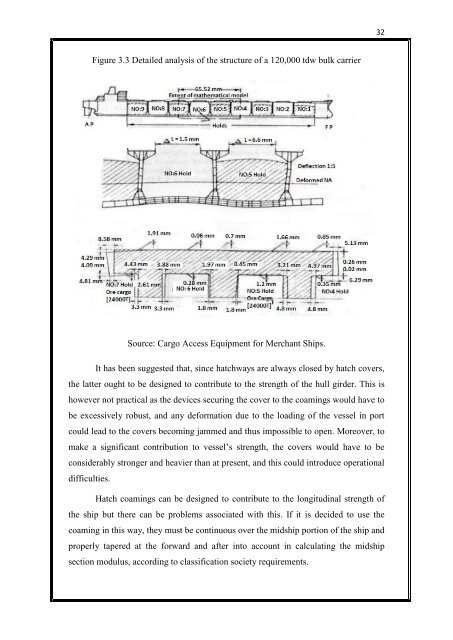Single pull macgregor type hatch cover.pdf - Cochin University of ...
Single pull macgregor type hatch cover.pdf - Cochin University of ...
Single pull macgregor type hatch cover.pdf - Cochin University of ...
You also want an ePaper? Increase the reach of your titles
YUMPU automatically turns print PDFs into web optimized ePapers that Google loves.
Figure 3.3 Detailed analysis <strong>of</strong> the structure <strong>of</strong> a 120,000 tdw bulk carrier<br />
Source: Cargo Access Equipment for Merchant Ships.<br />
It has been suggested that, since <strong>hatch</strong>ways are always closed by <strong>hatch</strong> <strong>cover</strong>s,<br />
the latter ought to be designed to contribute to the strength <strong>of</strong> the hull girder. This is<br />
however not practical as the devices securing the <strong>cover</strong> to the coamings would have to<br />
be excessively robust, and any deformation due to the loading <strong>of</strong> the vessel in port<br />
could lead to the <strong>cover</strong>s becoming jammed and thus impossible to open. Moreover, to<br />
make a significant contribution to vessel’s strength, the <strong>cover</strong>s would have to be<br />
considerably stronger and heavier than at present, and this could introduce operational<br />
difficulties.<br />
Hatch coamings can be designed to contribute to the longitudinal strength <strong>of</strong><br />
the ship but there can be problems associated with this. If it is decided to use the<br />
coaming in this way, they must be continuous over the midship portion <strong>of</strong> the ship and<br />
properly tapered at the forward and after into account in calculating the midship<br />
section modulus, according to classification society requirements.<br />
32

















